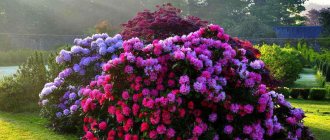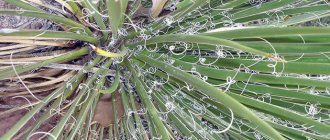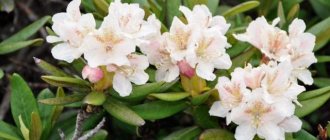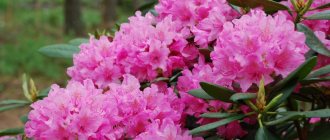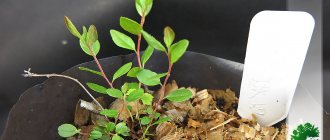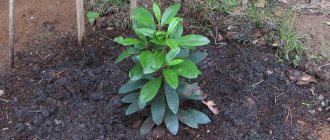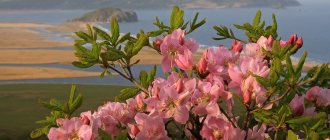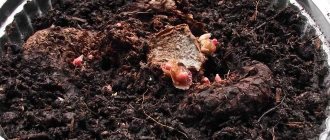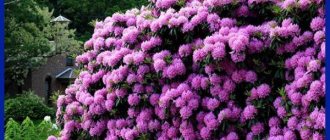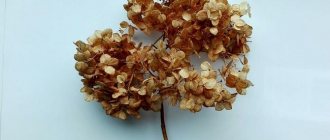Rhododendrons in the Moscow region planting and care
Unsurpassed flowering shrubs will be the best choice for garden decoration. They can hide an unsightly corner with a luxurious crown or become a wonderful frame for the facade of a house. The many-sided azaleas are especially beautiful, delighting anyone who meets them. Residents of the South of Russia can safely plant such plants and take minimal care of them. But what about in the middle zone? Caring for exotics there is much more difficult, and cultivation can be radically different. In this article we will tell you how to grow rhododendrons in the Moscow region: planting and care, key points of agricultural technology, reproduction. This material will allow you to choose a suitable cultivar, which, with the right agricultural technology, will delight you with lush flowering even in harsh climates.
Types and varieties for cultivation: names, descriptions and photos
To grow rhododendrons in central Russia, the following types are used:
| Name | Type | Height, m | Flower size, diameter, cm | Tolerable temperature, °C | Features and Notes |
| Golden (kashkara) | Evergreen | 0,6 | 5 | -26 | |
| Katevbinsky | Evergreen | 4 | Inflorescences 12-15 | -32, roots up to -18 | Fast growing |
| Canadian | Deciduous | 1 | 2,5 | -32 | Spherical |
| Japanese | Deciduous | 2 | 6-8 | -26 | Fragrant |
| Daursky | Evergreen or deciduous | 2 | 2-4 | -45 | Often called wild rosemary |
| Rhododendron Schlippenbach | Deciduous | 2 | 5-8 | -26 | Fragrant, blooms in late April |
| Rhododendron Costera | Deciduous | 3 | 4-7 | Winter-hardy | Fragrant |
As for varieties, the following can be recommended for cultivation in the Moscow region:
| Name | Type | Height, m | Color | Tolerable temperature, °C | Features and Notes |
| Grandmother (Babuschka) | Deciduous | 0,5 | Hot pink terry | -30 | Ball-shaped, grows slowly |
| Golden Lights. | Deciduous | 2 | Salmon-orange | -42 | Ball-shaped, fragrant |
| English Roseum. | Evergreen | 2,5 | Lilac-pink, with orange splashes | -30 | Not afraid of rain and direct sunlight |
| Karens | Evergreen | 1,5 | Reddish purple | Winter-hardy | Fragrant |
| Mount Saint Helens | Deciduous | 1,8 | Salmon pink color with golden tangerine flecks | -32 | |
| Nova Zembla | Evergreen | 2,5 | Hot pink with maroon spots | The most comfortable – from -15° to +25°С, but can withstand up to -32°С | Resistant to heat and direct sunlight, spherical |
| PJM Elite | Evergreen | 2 | Raspberry pink | -32 | Loves partial shade |
| Rosy Lights | Deciduous | 1,8 | Hot pink | -42 | Fragrant |
| Roseum Elegans | Evergreen | 3 | Pinkish lavender | When protected from wind - up to -32 | Fast growing, heat tolerant |
| White Lights | Deciduous | 1,5 | Pink-pearl | -42 | Fragrant |
These are not all varieties suitable for cultivation in central Russia. So the choice is very, very extensive. Below are photos of some varieties.
Rhododendron: origin, description, photo
Rhododendron is a shrub from the heather family. Less commonly, the plant reaches the size of a tree. The name comes from two words that are translated from Greek as “rose tree”. The delicate inflorescences really look like roses. Wild species are found in most parts of the world, but are mostly concentrated in the Northern Hemisphere - China, Southeast Asia, and the Himalayas.
Their appearance also changes depending on their natural habitat. Shrubs live in the undergrowth and valleys, creeping varieties grow on mountain screes, and in open coastal areas you can find real giants, the height of which reaches 5-25 m. The flowers differ in the color of the petals, the shape of the corolla and the size. Some types have flowers over 20 cm in size.
This is interesting! In addition to decorative landscaping, rhododendron has found application in medicine and perfumery. Extracts are included in medications for epilepsy and heart drops.
Deciduous cover can be annual, biennial or perennial, i.e. deciduous or evergreen. The plates differ in shape and size. They can be sessile or petiolate, whole or with serrated edges. The leaves are often oval, with a small edge on the surface.
The blossoming of the rose tree amazes with its splendor. The buds, collected in large brushes or scutes, have a slightly asymmetrical corolla. The color of the petals is so varied that even an experienced gardener will find a specimen to his liking. After the flowers wither, multi-seeded boxes with five leaves are tied. Seeds that look like sticks ripen inside. The root system is fibrous, lies in the upper layers of the soil, growth is slow. It propagates both generatively (seed) and vegetatively - by cuttings, layering, and dividing the rhizome. This bush lives for over 20 years.
Know! Most members of the genus rhododendron are poisonous. All parts of the bush contain a plant neurotoxin that depresses the central nervous system.
Origin, natural habitat
Origin, natural habitat of rhododendron in the Ural mountains
Rhododendrons are the name of a genus that includes many species of deciduous, semi-evergreen and evergreen shrubs and trees.
To create the most favorable environment for development, it is worth remembering their habitat. The geography of distribution is quite wide. These amazing shrubs prefer places with high humidity - the coasts of seas, oceans, and large rivers. You can meet them in semi-shaded areas or on the northern slopes of the mountains. The soil in the growing areas is acidic, rich in nutrients and well permeable to moisture.
The best varieties of rhododendron for the Moscow region
It is not surprising that such diversity attracted the attention of breeders. Having selected one of the local species, the British began to send botanical expeditions to Asia. Thanks to botanist-researcher George Forest, over 300 wild varieties were discovered in Southeast Asia, which formed the basis for selection. Since the beginning of the 19th century, the developments of scientists have made it possible to develop over 3 thousand garden cultivars.
Rhododendrons are most often used in ornamental gardening in regions with a temperate continental climate:
- Ledebura;
- katevbinsky;
- Smirnova;
- golden;
- Schlippenbach;
- Japanese;
- short-fruited;
- Daurian;
- Canadian.
Let's take a closer look at their main characteristics and popular varieties.
Ledebura, or maral, grows in the forests of Siberia, Altai and Mongolia. It is a semi-evergreen upright bush 50-200 cm high. Shiny small leaves are covered with small scales or edges. They overwinter and are replaced after flowering, which occurs in March and repeats in September. The corollas are bell-shaped, painted in pink-violet shades. The flowers are asymmetrical with long pink stamens. Resistant to temperatures down to minus 32⁰C.
Daursky. Outwardly, it is difficult to distinguish it from the maralnik. The leaves do not overwinter, but fall off with the onset of autumn. Decorative appearance occurs between the end of April and mid-June. It blooms for about 20 days. The corollas are light pink with a purple tint, funnel-bell-shaped, 2-4 cm. It grows in the territory located east of the Altai Range - Eastern Siberia, the Far East, Korea, Japan, Manchuria. The second name is wild rosemary. The seeds have high germination capacity and are frost-resistant. The cultivars are more stocky with purple flowers. Its frost resistance is much lower than that of botanical wild rosemary.
Know! Daurian wild rosemary, unlike its marsh relative, contains a much smaller amount of essential oils, so it does not cause headaches. Used in medicine and perfumery.
Katevbinsky. Formed the basis for most frost-resistant evergreen hybrids. Grows in the forests of North America. The height of the spreading crown is 2-4 m. The leaves are large, elliptical, length 10-15 cm, width 3-5 cm. The surface of the plate is dark green, glossy, with pronounced veins, the lower part is pale. The corollas are bell-shaped, colored lilac or white, sometimes with yellow-green specks. The flower size is 5-6 cm, there is no smell.
Decorative for a month at the end of spring or beginning of summer. Several compact hybrids with white and lavender speckled petals have been developed - Catawbiense Album, Catawbiense Boursault, Catawbiense Grandiflorum, Nova Zembla, Alfred. Life expectancy is about 100 years.
Smirnova. A dense evergreen bush 1-1.5 m tall. The leaves are large, elongated-elliptical, shiny on top and with dense white pubescence in the lower part of the blade. Length 10-15 cm, width 2.5-4 cm. Corollas are purple-pink, funnel-shaped, up to 7 cm, dense inflorescence. Inside there are 10 pubescent stamens and a bare pistil. The petals have yellow specks. Grows in Turkey on high mountain slopes. Used for hybridization of cold-resistant varieties. Varieties - Dorothy, Laika, Gabriel.
Kashkara, or golden rhododendron, lives in Siberia and the Far East, often forming impenetrable thickets. Yellow flowers 4-5 cm in size are collected in large umbrellas. Blooms in early summer. The leaves are dense, small, evergreen. The growth rate is very slow, winter hardiness down to minus 26⁰C.
Know! Despite their unpretentiousness, low (up to 0.5 m) creeping kashkar bushes take root very difficultly outside their natural habitat.
Schlippenbach. One of the most luxurious deciduous rosewood species. The spreading crown, 1.5–1.8 m high, is topped with medium-sized leaves. Large fragrant flowers 7-8 cm appear in early May. The petals are pink or white, the inflorescence consists of 4-5 pieces.
Canadian. A low-growing compact shrub 0.7–0.9 m high. Found in the eastern part of North America. Small leaves are colored in greenish-blue tones. The flowers are collected in small shields of 3-7 pieces. The main range of petals is pink-violet and odorless.
Japanese. Grows in Southeast Asia. Widely used in Russia as one of the most decorative, unpretentious and frost-resistant. The average height of the highly branched crown is about 1.5 m. It blooms profusely at the end of May for 3-4 weeks. The corollas reach 6-8 cm, collected in lush inflorescences. They are colored salmon or red with a yellow spot. A lot of hybrids have been bred on its basis.
Short-fruited. An evergreen giant, 4–6 m tall. Habitat: Asia, Kuril Islands. The leaves are leathery, dense, large. The flowers are pink or white, collected in umbrella-shaped shields of 12-15 pieces. Blooms in mid-summer. The first budding occurs on the tree at the age of 18-20 years.
Hybrid rhododendron is a collection of various cultivars grown in the garden.
On a note! Among the mass of hybrids, give preference to samples of Finnish selection - Elvira, Micheli, Hague and the “Northern Lights” series.
Description of Rhododendron Katevbinsky Grandiflorum
Rhododendron hybrid Katevbinsky Grandiflorum belongs to the Heather family. One of the oldest varieties of rhododendron, obtained at the beginning of the 19th century. It forms a spreading, highly branched bush 2-4 m high. The shrub is a fast-growing one, the annual growth is 8-12 cm. It forms a semicircular, dense crown. The size of Rhododendron Katevbinsky Grandiflorum in diameter is 2-3 m. It can grow in one place for about 100 years.
The bark color is brown. The leaves are medium-sized, elliptical, 7-8 cm long. They are dark green, shiny, and smooth on top. Below they are pale, leathery, without pubescence. The inflorescences are compact, uniting 13-15 flowers, 6-7 cm in size. The photo of the rhododendron Grandiflorum shows a purple tint of the flowers with an orange spot interspersed on the upper petal. The stamens are long and curved. Flowers without fragrance. The buds bloom in early summer.
Rhododendron in the Moscow region - growing features
The cultivation of exotics in the Moscow region has a lot of subtleties. Many varieties are used in culture, but not all of them are suitable for the harsh climate of the Moscow region. The weather in this region is very unstable - in winter temperatures can drop below 35⁰C, in summer the thermometer can show 40⁰C. The distribution of precipitation is also uneven.
Frosts leave the region in early May and arrive at the end of September. Due to such weather fluctuations, the Moscow region belongs to the risky farming zone. Accordingly, in order to grow a decent harvest or any exotic plant, a competent approach will be required. You need to select Asian seedlings based on the climatic characteristics of the region. Only frost-resistant cultivars are suitable for the Moscow region. Planting and caring for exotics will be described in detail below.
Rhododendron Yellow
The yellow variety is a branched shrub reaching a height of 1.5 meters. The plant grows up to three meters wide. There are quite a few subspecies that differ from each other only in size and shades of foliage. The flowers are bright yellow in color, collected in large inflorescences and exude a wonderful aroma. The plant blooms in the second half of May and pleases gardeners for two to three weeks. This variety is completely undemanding to the soil and can grow even on loam.
Planting rhododendron in the Moscow region
In order for the azalea to give you bright colors, you will have to work hard and find the right place for it. After all, proper planting is the key to plant health.
It is important to choose the right planting material. It is better to make a purchase in specialized garden centers or nurseries. The second option is preferable, because the young shoots have already adapted to the climatic conditions of the region.
A good seedling aged 2-4 years has many branches from the root collar. Its foliage is even and smooth, without signs of injury, drying out, or spots. A closed root system is welcome. The roots protruding from the earthen clod should be free of knots and signs of spoilage.
If the material was purchased in the fall, it can be buried in a shady corner of the garden and be sure to organize a winter shelter. A dry, ventilated basement will also help preserve the cuttings until spring. Storage temperature is about 12⁰C, watering is very rare, it is better to spray the seedlings.
Important! Avoid buying cuttings at markets or spontaneous fairs. The purchased specimen will easily turn out to be of a different variety and will die under improper growing conditions.
Choosing a landing site
You should choose a place for an exotic garden inhabitant based on its natural living conditions. This tactic allows you to minimize stress.
Exotics can be planted throughout the season, with the exception of flowering time. However, the best period will be early spring. Since in the wild, almost all exotics grow under the canopy of trees, such a neighborhood will only benefit them. But you need to choose neighbors for an Asian very selectively. If the neighbor’s root system is taprooted and goes deep into the soil, then the plant will feel comfortable.
Pine, apple, larch, pear, cherry, oak are suitable. Neighborhood with birch, linden, maple, elm, willow, and alder will have a bad effect on your green ward. These trees have fibrous roots that lie in the same layers as those of the Asian guest. In the struggle for space and food, both representatives of the flora may die.
Important! Planting near trees is possible only at a distance of half the projection of the tree crown.
A shaded area on the northern side of the garden during the daytime is ideal. It is important that groundwater does not lie close to the soil surface. In this case, it is necessary to organize drainage or plant on high beds. When planning to plant a plant near buildings, make sure that it does not end up in the area where snow falls from the roof. Try to avoid windy areas where there is minimal snow cover in winter.
Soil characteristics
For an Asian resident, the composition of the substrate is very important. The soil pH plays a huge role. For proper development and health, exotic requires an acidic environment in the range of 4.5-5.5. If the soil does not meet this characteristic, it should be acidified. The introduction of high-moor peat, sulfuric acid fertilizers and special heather soil is encouraged.
The substrate should be loose and well-permeable, nutritious. A mixture of loam, acidic (high-moor) peat and pine litter in equal parts will help to ensure such properties. Clay will make the soil denser and prevent it from spreading during watering and rain. Pine needles acidify the soil, maintaining an optimal pH level, making the substrate loose and permeable. Peat also has oxidizing properties and a high humus content.
Remember! If you use clay instead of loam, then its amount must be halved. To prepare the substrate, you should not use humus, manure, sawdust, ash, or black soil, as they alkalize the soil.
Preparing the plant for planting
To prepare a seedling for planting, it is enough to place its root system in a bucket of water until bubbles stop appearing on the surface. It is better to plant young plants in small holes in the shade. In 2-3 years they will be fully strengthened and will be ready to show themselves in all their glory in a larger area.
Landing technology
To avoid stagnation of water in the roots, it is recommended to plant bushes on high mounds or organize a drainage layer 15-20 cm high. It is made of crushed stone or broken brick. The rose tree will not need a hole that is too deep, because the root system is of a superficial type.
To plant, use the following algorithm:
- dig a hole measuring 60 by 60 cm and 40 cm deep;
- lay out a drainage layer;
- fill part of the hole with substrate so that the root collar is level with the soil;
- compact the earthen mixture and place the seedling in the hole, straighten the roots;
- add the required amount of substrate, tamp;
- water generously and mulch the tree trunk circle with peat, pine needles or oak leaves;
- If necessary, install temporary support.
Advice! To ensure rooting is successful, remove some of the inflorescences. This way, you stimulate the development of the root system. If planting on a hill, be sure to line the shaft with large stones. They will help keep the mound intact during watering and during the rainy season. This frame will harmoniously fit into the design of your garden.
How to grow rhododendron katevbinsky grandiflorum?
Rhododendron katevba grandiflorum is a hybrid garden shrub of the heather family.
This is a plant that will not leave any gardener indifferent thanks to its beautiful pink flowers. But in order for a shrub to please the eye for many years, it needs proper planting and care. Katevbinsky rhododendron is a medium-sized shrub; it grows up to four meters in height, with large, dense leaves. They are large, elongated, dark green in color with a glossy sheen. However, the shrub is of greatest value during the flowering period.
The entire bush is covered with large, about 6 cm in diameter, pink flowers. The shape of the flowers is similar to bells, which are collected in clusters. In one such “bouquet” there are up to 20 flowers at once. For its beautiful flowering, the shrub received its second name - “pink tree”.
The color shades of this type of rhododendron are quite varied. Its flowers can be white, pink, lilac, violet-red. The flowering season begins in May and lasts about a month, after which fruits begin to form on the plant. The seeds are finally formed only by October.
Rhododendron Katevbinsky usually arrives at a gardener’s garden plot in the form of a seedling purchased in a store.
In order for this seedling to take root successfully, it is necessary to choose it correctly. Seedlings, as a rule, are brought to garden centers from warm countries, and this already suggests that they may not take root in the harsh climate of our country. For the climatic zone of Russia, it is best to choose seedlings that grew in conditions similar to those in Russia. Such conditions exist, for example, in nurseries in Finland.
It is important to know that you should not purchase adult plant bushes or rooted cuttings!
When purchasing, you should pay attention to a bush with a good root system, which is 2-3 years old. You need to look carefully at the leaves of the plant. They must be absolutely healthy and show no signs of disease.
You can plant shrubs in your garden not only in the spring, but throughout the summer, until the very end of August. You need to choose a sunny place, but the rays of the sun there should not be scorching all day, but scattered. An excellent option is partial shade under a tall tree. But the bush should not be planted under the tree itself, but at a distance no closer than 2 m to it.
Rhododendron grandiflorum is very picky about the soil in which it is planted.
It belongs to the heather family, and therefore it needs loose, peaty soil, rich in humus, with an acidity pH of 4.5 - 5.5. This acidity is achieved by mixing fallen pine needles with coarse sand. Therefore, a place under spruce, larch or pine needles is ideal for this shrub.
The planting hole for this plant does not need to be too large, since its root system is quite compact. Ideal pit dimensions: diameter - 60 cm and depth 40 cm. It is better to prepare the pit two weeks before planting the plant. For this pit you will need 7 buckets of soil. It is prepared, mixed, poured into the planting hole and compacted. After the plant is ready for planting, dig a hole corresponding to the root of the plant, plant it in this hole and bury it with soil.
In this case, the bush should be planted at the same depth at which it grew before in a container in the store. When planting, you need to try to be careful and not damage anything.
Of course, like any other plant, rhododendron needs not only timely planting, but also care. This care must be correct. It should include timely planting, watering, and processing. At the same time, it is important to remember that in no case should you loosen the soil under the bush, since this will disrupt the symbiosis of mushrooms and plants.
Because of this, weeding should be carried out exclusively by hand; weeds should not be removed using hoes, and even more so, they should not be removed using gardening equipment.
It is necessary to water the bush regularly, as it is very afraid of drought. In especially warm summers, watering should be done at least once a week.
If the bush has grown large, then the amount of water that will be spent on watering it will be from 50 liters at a time. It is best to water it early in the morning or evening with rainwater. Under no circumstances should you use tap water without first preparing it. Tap water needs to be settled, or better yet, softened. The simplest means for softening water is a solution of one percent acetic acid (2 tablespoons per 10 liters of water). You can also use citric acid. In this case, the same volume of water will require 3-4 g.
Young rhododendron, which has been growing on the site for less than a year, is not fed!
But after a year, feeding becomes regular. Feed the shrub in the spring, once a year, with a special long-term fertilizer, which can be bought at a gardening store.
Caring for rhododendron in the Moscow region
If the Asian guest was planted in compliance with agricultural technology, then it will require minimal care. Mulching can retain moisture, which the bush values so much, avoid the riot of weeds and protect the delicate roots from overheating. Weeding will have to be done exclusively by hand. This measure is necessary to protect surface roots from mechanical damage. Loosening the earth is unacceptable for the same reason.
Watering
The rose tree loves to drink, and not just plain water, but soft water. Rain or river water will be ideal for it, settled water is also suitable. To soften, add a couple of handfuls of peat a day before watering. The plant suffers greatly from lack of moisture. The first signal of “thirst” will be drooping foliage and loss of glossy shine. Watering is carried out frequently, but in small portions. This way, water will not stagnate near the roots. The soil should get wet by 20-30 cm. Our exotic ward loves spraying.
Important! Avoid exposing sprayed leaves to sunlight, otherwise burns will occur. It is better to carry out the procedure early in the morning or after sunset.
At the end of August, watering is reduced to a minimum. If this is not done, the bush will begin to produce side shoots and will not have time to prepare for winter. Autumn in the Moscow region can be full of rain or very dry. During the autumn drought, water in small portions, monitoring the turgor of the foliage.
Fertilizing
Azalea will gratefully accept feeding. There are many mineral complexes on sale designed specifically for these plants. Dilute it according to the instructions and apply during watering. Sucking Kemira-universal is no less effective. It is sold in granules, which should be scattered around the bush at the rate of 1-2 tablespoons for each specimen over 40 cm in height. In order not to disturb the acid balance of the soil, use superphosphate and salts of sulfuric or nitric acids - ammonium sulfate, potassium nitrate. The average application rate is 50 grams per square meter.
Having chosen a treat for your pet, remember that it should be added until the end of June, twice a month. Starting from July, fertilizing is prohibited. This measure will ensure the preparation of the bush for wintering, and not the growth of green mass.
Know! Wood ash solution should not be used as fertilizer. It will significantly reduce the acidity of the soil and cause chlorosis of the foliage.
Choosing a landing site
Garden rhododendron is planted in the northern or northeastern area of the site. The bush does not withstand direct sunlight, which even in February can destroy young buds formed in August.
In the Moscow region, flowers are planted near a fence or hedge, which will protect the crown from the scorching sun during the day. The bush needs shading. To do this, in the spring it is covered with special shields or a dark film is pulled over high stakes installed around the bush. The protection is raised 10-15 cm above the ground to ensure free air circulation.
Rhododendron thrives around trees with deep roots. They bloom profusely in their shade and serve as a kind of decoration for the trunks. When planting alone, it is advised to tie the bush to a support so that it is not broken by strong winds.
Rhododendron pruning
Since the exotic bush forms a regular crown, it practically does not require pruning. It is carried out to sanitize and rejuvenate the tree. In early spring, before sap flow begins, shoots damaged during the winter are cut out. Branches more than 2-3 cm thick will require treatment with garden varnish. The composition will not allow infection to enter through an open wound. For rejuvenation, half of the shoots are cut off at a height of 40 cm. The second half is removed the next season. Corrective pruning, the purpose of which is to make the crown more compact, is carried out after flowering.
How to plant rhododendron correctly
Growing rhododendrons in the Moscow region requires more attention from gardeners than in the southern regions. But with the right approach, you can achieve abundant flowering of the plant. Rhododendrons have a fairly compact fibrous root system, so if the plant is properly removed from the soil, replanting is completely painless. Rhododendrons love moisture very much, but at the same time they cannot tolerate excess water. Therefore, drainage is recommended in flooded or swampy areas.
Since plants have a compact root system, you should not dig large holes when planting. The optimal size of the hole is forty centimeters in depth and sixty in diameter. The prepared hole is filled with a substrate (its composition was given earlier), after which the soil is compacted. Next, dig a small hole large enough for the small roots of the plant and plant the rhododendron in it. Immediately before planting, the roots must be immersed in water for a while and kept there until air bubbles stop appearing. The plant is planted at the same depth at which it grew in the container. Excessive deepening can only harm the plant.
Under no circumstances should you use black soil, manure, and sawdust as components for the substrate.
How to propagate rhododendron in the Moscow region
Exotic propagates both by seeds and vegetatively. When sowing seeds, you will have to wait quite a long time for flowering - from 6 to 8 years.
Cultivating seedlings is not that difficult, but protecting young shoots from frost is unproductive. Therefore, in the Middle Zone, generative reproduction is used extremely rarely. If you want to try your hand and spend time, sow the seeds in small boxes. As a substrate, use leaf soil and sand in a ratio of 3:1.
Cover the crops with glass and place them in the light. Care consists of maintaining normal watering, eliminating stagnation of water and its lack. Plant the grown seedlings into separate containers and grow them throughout the year in a cool greenhouse. Next spring, plant them in a shady location. Always protect young shoots from frost.
An equally complex process is propagation by cuttings. Cuttings 7-8 cm long are cut from semi-lignified branches. Excess leaves are removed and the cut is soaked in a growth stimulator. For rooting, use the same substrate as for sowing. Within 3-4 months, the cuttings will take root in a small greenhouse. For the winter, the sprouts are brought into a bright, cool room, and in the spring they are taken out into the garden. It is possible to plant cuttings in a permanent place only after 2 years.
Obtaining layering is an ideal way to propagate a rose tree in the Moscow region. Young branches are buried in early spring into grooves 15 cm deep. The crown is tied vertically. Care is minimal - water and feed along with the mother liquor. Layers are separated in autumn or early spring and immediately planted in a permanent place.
Know! Deciduous species reproduce best with the help of layering.
Mandatory preparation for winter
- Mulching is mandatory for all types and varieties.
- Evergreen species winter worse in northern regions than deciduous ones. Therefore, for deciduous species, it is enough to sprinkle 12-15 cm (bush above 80 cm) or 20-25 cm (bush above 150 cm) with a layer of peat, pine needles, heather soil or foliage (birch, oak or linden). The main thing is not to hill up or fill the base of the bush on top. It is advisable to cover it with coarse sand so that the bark does not prop up in the spring.
At the same time, there is no need to remove fallen leaves, bark or small branches of rhododendron - they serve as natural protection from frost, and will subsequently become the top layer of soil.
Deciduous and evergreen rhododendrons in the Moscow region, planting and care
Regardless of what type of cultivar you choose, deciduous or evergreen, following the rules of its cultivation will allow you to enjoy the decorative properties of the pink tree for a long time. Let's summarize a little about agricultural technology in the Moscow region:
- choose only frost-resistant varieties;
- Monitor the acidity of the substrate, its range is 4.5-5.5. If necessary, add peat and special fertilizers;
- carefully consider the choice of location and neighbors of the rose tree;
- do not add substances that alkalize the soil - ash, lime, organic matter, dolomite flour;
- mulch tree trunk circles with peat or pine litter;
- Weed by hand;
- water in small portions in a timely manner, spray;
- do not apply fertilizers in the second half of summer;
- be sure to provide drainage in the planting hole.
There are a few more nuances. After the buds wither, the inflorescences are carefully removed. The plant will not waste its energy on ripening the seeds, it will begin to prepare for the dormant period and accumulate strength.
On a note! In warm autumn, the bush can begin to grow shoots. Spraying with a 1% solution of potassium sulfate will help slow down the growth process.
To prevent evergreen bushes from being damaged by the spring sun, cover them with a double layer of burlap or spunbond. Monitor the presence of high snow cover in the area. Snow is the best shelter in a frosty winter.
Winter shelter for rhododendron
The main purpose of the shelter is to protect the rhododendron from strong winds and heavy snow; they are more likely to cause damage than low, stable temperatures.
- After the arrival of stable cold weather (late October - mid-November), the branches need to be carefully tied. It is better to tie a tall bush to a support. And flexible species (Schlippenbach, some hybrids) are better to tilt for wintering under the snow (at least part of the bush) and imagine how it will lie so as not to break the stems.
- Drive a high stick near the bush and put a cover made of white burlap, agrofibre or light fabric (sheet, duvet cover) on the bush or cover it with lutrasil (spunbond). Such a shelter will protect the plant from the scorching spring sun, the branches will not get tangled and will easily straighten out in the spring. And thanks to the stick, the snow will roll down and the branches will remain intact.
- Instead of sticks, you can drive supports into the corners and attach covering material (hut, frame or house) to them, so that if a lot of snow falls in winter (100-140 cm in height), it does not press the branches to the ground.
Then in the spring the bush will need more effort to restore the shape of the stems, and flowering will worsen. You can put spruce branches inside.
Adviсe
- Covering with a fabric or burlap cover is useful for all types of rhododendrons exposed to the sun in winter. Especially important for evergreen specimens.
- For a low bush, you can make a standard frame air-dry shelter, which can be used to cover, for example, hydrangeas , or cover it in a circle with spruce branches (“hut”) and cover it with a box/box on top.
- It is especially important for flower growers in the Middle Zone (Moscow region, Rostov-on-Don, Nizhny Novgorod) to provide shelter for the winter, since thaws occur in winter (even in late December - early January).
- According to reviews from flower growers in the North-West (Leningrad region), species-specific rhododendrons winter well without any shelter and do not break, burn or freeze. All thanks to the proximity of the sea (high air humidity).
Pests and diseases
If agricultural practices are followed, the bushes are practically not exposed to various diseases and damage. Noticing drying of the leaves or the appearance of yellowness on the blades while maintaining the network of green veins, we can talk about chlorosis. The disease is caused by a violation of the acidity of the soil; the addition of iron supplements will help to overcome it.
Rust is a disease caused by a pathogenic fungus. It is manifested by the presence of bulges on the leaves, cracking and growing over time. The fungus will die after treatment with Bordeaux mixture.
Spotting is characterized by the appearance of small specks of various colors. As the mycelium of the pathogen grows, the degree of damage increases. Copper-containing preparations will stop the activity of the fungus. You can use fungicides, for example, Fitosporin.
Leaf swelling is also caused by a pathogenic fungus. It is determined by the appearance of spherical formations on the plate. The affected parts are removed and treated with a fungicide.
Various rots are also destroyed by Bordeaux mixture, the preparation "Hom", "Topaz". The mosaic virus manifests itself by yellowing of the leaf and the formation of characteristic angular spots of various colors on the surface. Infected copies are immediately destroyed.
Remember! Carrying out preventive treatment with Bordeaux mixture in spring and autumn will help reduce the risk of fungal diseases.
Azaleas have quite a lot of pests - shellless slugs, scale insects, mealybugs, aphids, weevils, spider mites. Systemic insecticides will destroy the horde of those who want to taste the greens. Use the drugs "Actellik", "Comfidor", "Intavir", "Karbofos". A soapy shower is also effective against aphids and mites; slugs are afraid of the aroma of bleach and prickly mulch. Rhododendron in garden design
Lush growth, replete with fragrant flowers, is a favorite tool of landscape designers. The bushes look great both as tapeworms and in an ensemble with other plants. Azalea will be an excellent decoration for the facade, framing an artificial pond, and will fit on a green lawn or in a rocky rock garden, on an alpine hill.
As neighbors, select decorative foliage plants - hosta, barberry, fern, low-growing conifers. Rosewood combines luxuriously with spring bulbous crops, peonies, and hydrangea.
Conclusion
As you can see, if you follow the planting rules and carefully care, rhododendron can grow in the Moscow region. A luxurious shrub will become the calling card of your garden plot and will evoke a lot of positive emotions.
When can you open rhododendron after winter?
It is necessary to gradually remove the cover from rhododendrons in the spring, especially from young bushes, so that it is easier for them to adapt to changing weather conditions.
- After most of the snow has melted (mid-March - early April), the “pink tree” needs to be ventilated, and then small gaps should be left on the sides for ventilation.
- After the soil has thawed 20-30 cm deep, in the evening or on a quiet cloudy day, you can open the rhododendron completely. Moscow region, Middle zone, Leningrad region - April 5-15. Ural, Siberia - April 15-25. Then it is advisable to shade the plant with spruce branches (leave it if there was one).
- After removing the winter cover of the evergreen “rose tree”, the leaves, drooping and twisted, but with the beginning of the growing season, are leveled and straightened - which means everything is in order with it and the wintering was successful.
Frozen leaves of an evergreen rhododendron after removing the winter shelter (First, just cut them off, and after a month see if new ones begin to grow)
